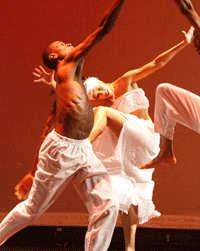As Toronto is still abuzz from last weekend’s mesmerizing performances by the Alvin Ailey American Dance Theatre marking their 50th anniversary, Dance Immersion keeps us on our dancing toes with their upcoming showcase presentation of the acclaimed Denver-based Cleo Parker Robinson Dance Ensemble. In its 38th year, the Cleo Parker Robinson Dance Ensemble is one of the top Black dance companies in the United States.
CPRD [Cleo Parker Robinson Dance Ensemble] will pay homage to the works of the legendary choreographers Alvin Ailey (1931-1989) and Katherine Dunham (1909-2006) at Harboufront’s Enwave Theatre between May 29th - 31st, 2008. In addition, Artistic Director Cleo Parker Robinson will be in residence following the Showcase presentation for the week of June 2 - 8 to conduct workshops in CLEODANCE - a method that deals not only with the technique of a dancer but their heart, mind and spirit. The workshops will take place at the National Ballet School.
AfroToronto.com had the opportunity to speak recently with Cleo Parker Robinson, who is directly from Denver, and Dance Immersion’s Artistic Director, Vivine Scarlett.
Cleo Parker Robinson told us that she was looking forward to coming back to Toronto for the second time to perform. CPRD first performed in Toronto last year when the International Association of Blacks in Dance Conference (IABD) was in town. Organized for the first time outside the U.S. by Dance Immersion, whose mandate is to support and showcase dancers and dances of the African Diaspora, last year’s IABD was a great opportunity to bring in, quoting Vivine Scarlett, “a lot of international professional artists – which infused a lot of things into the community - dance and otherwise. Cleo Parker Robinson was really well received, so we decided to bring her back.”
We get a great sense of Cleo Parker Robinson’s truly community-focused approach to dance when she talks to us about her dance master class which she will teach at the National Ballet School for the week of June 2nd-8th:
“You have to experience it. I called it Cleo Dance because it is a combination of all of the great teachers that I’ve had and the wonderful experiences ... It will happen because of who comes. The way that class is shaped is based on who is present. If there are musicians, then the musicians have a role. If there are poets, they have a role. ... I learned to be, I guess you should say, really flexible and pliable. I mould the experience to the vibration of the people who are present. ... I think teachers can be very boring.”
She humorously recounts how she would walk into one of her own classes and ask the students present: “Who is the teacher?” They would say, “I don’t know”. “They walked into the class not knowing who the teacher was, but they definitely knew who the teacher was when they left. When they do a Clio Dance, they are privy to know not only who the teacher is but ... they know who they are,” she adds.
This approach and philosophy definitely fit within Dance Immersion’s belief that “what needs to happen for the dance artists’ growth is inspiration, connections with other artists,” as Vivine Scarlett explains.
In Cleo Parker Robinson’s own life, dance entered her world in just such a communal fashion. She grew up in Denver, Colorado, and was introduced to performing arts and dance in a theatre where her father was the janitor.
“What I learned early is if you’re exposed to the arts, you can have an inspiration. I want to do that. You’ve got to be inspired.”
By the tender age of fifteen, Cleo Parker Robinson got a job teaching dance at a neighbourhood youth program. Robinson recounts her amazing story:
“I was paid to teach dance very young. ... I learned to drive at 16, and I was running around teaching dance. I loved children. But I had another teacher who, at that time, taught at the University of Colorado ... she said I would like you to take over my classes at the university. I’ll be back in a week. She didn’t come back in a week and when she did come back, she said: “Cleo, those classes are yours.” So I continued to teach. ... sort of circumstantial by they become your destiny.”
Growing up during segregation, the product of a bi-racial marriage, she found that dance was one thing that brought all races together, particularly in her small community in Denver. “You would find Blacks, Whites, Chicanos, Asians, and Native Americans coming together through their love of music. And then, of course, when you have music, you’ve got dance. They loved to dance. You couldn’t keep me from dancing.”
Cleo Parker Robinson’s study of dance as an art form was highly influenced by the work of Alvin Ailey and Katherine Dunham. She would see them on television and was intensely aware that these were special cultural moments. Sharing those eye-opening experiences, she says:
“I loved the stories that related to the African-American experience because I didn’t get to see [much of that]. So I longed to know more about ... our community and about the culture. I knew that there weren’t enough of those storytellers.”
Katherine Dunham was a modern dance pioneer who is known for blending classical movement with African and Caribbean rhythms. She was known as the Matriarch and Queen Mother of Black Dance. Dunham was also a cultural anthropologist who travelled to the West Indies and elsewhere to study indigenous dances and their African roots. She helped bring a vital African-American dimension to modern dance. Dance legend Alvin Ailey credited her with influencing his technique and teaching.
Cleo Parker Robinson will pay tribute to her two great mentors next week at the Enwave theatre with performances of Passionate Spirit – which features several works by Dunham. Alvin Ailey will also be remembered with the sensual and jazzy Escapades.
“When I moved to New York when I was 19, I fell in love with Alvin Ailey. Not only Alvin Ailey and his company, but I fell in love with his school. Oh my god, the people and the world are here ... speaking all these languages. And I said that’s the kind of environment I want to create.”
Robinson also explains how her dance company’s direction was shaped: “One of the things that was important to me was to get to the Black community and change the attitude about dance. ... In order to do that, we had to deal with stereotypes. ... Culturally, we didn’t have Black men who danced. ... [it’s been often seen] as a waste of time ... a taboo. So dealing with those kinds of issues probably motivated me more. It made me determined to change that attitude.”
Dance Immersion’s Artistic Director, Vivine Scarlett, echoes Robinson’s sentiments when she speaks of her continued commitment to providing dance workshops to the community in the Jane & Finch area. She marvels at how, after proving their dedication, they have now been able to get Caribbean fathers to join in on dance and drumming sessions.
But there can perhaps be no greater inspiration for anyone than the story of Cleo Parker Robinson Dance Ensemble dancer Marceline Freeman. Now blind, she has been with the company for 36 years and will be performing in the Toronto shows next week. Describing her, Cleo Parker Robinson says that “she brings a great sense of integrity to the arts that young people who are coming to the arts need to have. ... [a] sense of devotion or purpose.”
dance Immersion presents the Cleo Parker Robinson Dance Ensemble
May 29 - May 31, 2008
Harbourfront Centre''s Enwave Theatre, 235 Queen''s Quay West
Performances: Thursday - Saturday at 8 pm; Friday and Saturday matinees at 1 pm
Evening Prices: $30; Students & seniors $25; Groups of 10+ - $20/person
Matinee Prices: $20; Groups of 10+ - $10/person
Box Office: 416-973-4000 Info: danceimmersion.ca OR 416-203-0666
Artistic Director Cleo Parker Robinson will be in residence following the Showcase presentation for the week of June 2 - 8 to conduct workshops in CLEODANCE, a method that deals not only with a dancer's technique but also with their heart, mind, and spirit. The workshops will take place at the National Ballet School.






